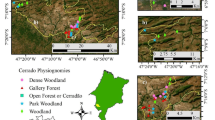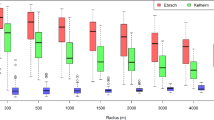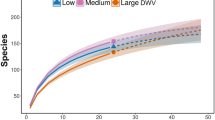Abstract
The conservation of traditional fruit orchards might be considered to be a fashion, and many people might find it difficult to accept that these artificial habitats can be significant for overall biodiversity. The main aim of this study was to identify possible roles of traditional fruit orchards for dead wood-dependent (saproxylic) beetles. The study was performed in the Central European landscape in the Czech Republic, which was historically covered by lowland sparse deciduous woodlands. Window traps were used to catch saproxylic beetles in 25 traditional fruit orchards. The species richness, as one of the best indicators of biodiversity, was positively driven by very high canopy openness and the rising proportion of deciduous woodlands in the matrix of the surrounding landscape. Due to the disappearance of natural and semi-natural habitats (i.e., sparse deciduous woodlands) of saproxylic beetles, orchards might complement the functions of suitable habitat fragments as the last biotic islands in the matrix of the cultural Central European landscape.


Similar content being viewed by others
References
Alexander KNA (2008) The special importance of traditional orchards for invertebrate conservation, with a case study of the BAP priority species the noble chafer Gnorimus nobilis. Landsc Archaeol Ecol 7:12–18
Bailey D, Schmidt-Entling M, Eberhart P, Herrmann JD, Hofer G, Kormann U, Herzog F (2010) Effects of habitat amount and isolation on biodiversity in fragmented traditional orchards. J Appl Ecol 47:1003–1013
Baum KA, Haynes KJ, Dillemuth FP, Cronin JT (2004) The matrix enhances the effectiveness of corridors and stepping stones. Ecology 85:2671–2676
Benes J, Cizek O, Dovala J, Konvicka M (2006) Intensive game keeping, coppicing and butterflies: the story of Milovicky Wood, Czech Republic. Forest Ecol Manag 237:353–365
Chevan A, Sutherland M (1991) Hierarchical partitioning. Am Stat 45:90–96
Chiari S, Carpaneto GM, Zauli A, Zirpoli GM, Audisio P, Ranius T (2012) Dispersal patterns of a saproxylic beetle, Osmoderma eremita, in Mediterranean woodlands. Insect Conserv Divers 5:309–318
Fahrig L, Merriam G (1994) Conservation of fragmented populations. Conserv Biol 8:50–59
Faltysova H (2002) Pardubicko. Chráněná území ČR, svazek IV. AOPK ČR and EKOCentrum, Czech Republic
Farkac J, Kral D, Skorpik M (2005) Červený seznam ohrožených druhů České republiky. Bezobratlí. AOPK ČR, Czech Republic
Franc N, Götmark F (2008) Openness in management: hands-off vs partial cutting in conservation forests, and the response of beetles. Biol Conserv 141:2310–2321
Goldberg E, Kirby K, Hall J, Latham J (2007) The ancient woodland concept as a practical conservation tool in Great Britain. J Nat Conserv 15:109–119
Graham MH (2003) Confronting multicollinearity in ecological multiple regression. Ecology 84:2809–2815
Haddad NM, Baum KA (1999) An experimental test of corridor effects on butterfly densities. Ecol Appl 9:623–633
Hedl R, Kopecky M, Komarek J (2010) Half a century of succession in a temperate Oakwood: from species-rich community to mesic forest. Divers Distrib 16:267–276
Hirzel A, Guisan A (2002) Which is the optimal sampling strategy for habitat suitability modelling. Ecol Model 157:331–341
Horak J (2013) Effect of site level environmental variables, spatial autocorrelation and sampling intensity on arthropod communities in an ancient temperate lowland woodland area. PLoS ONE 8:e81541
Horak J, Rebl K (2013) The species richness of click beetles in ancient pasture woodland benefits from a high level of sun exposure. J Insect Conserv 17:307–318
Horak J, Chumanova E, Hilszczanski J (2012) Saproxylic beetle thrives on the openness in management: a case study on the ecological requirements of Cucujus cinnaberinus from Central Europe. Insect Conserv Divers 5:403–413
Horak J, Peltanova A, Podavkova A, Safarova L, Bogusch P, Romportl D, Zasadil P (2013) Biodiversity responses to land use in traditional fruit orchards of a rural agricultural landscape. Agric Ecosyst Environ 178:71–77
Horak J, Vodka S, Kout J, Halda JP, Bogusch P, Pech P (2014) Biodiversity of most dead wood-dependent organisms in thermophilic temperate oak woodlands thrives on diversity of open landscape structures. Forest Ecol Manag 315:80–85
Jonsell M (2012) Old park trees as habitat for saproxylic beetle species. Biodivers Conserv 21:619–642
Konvicka M, Cizek L, Benes J (2004) Ohrožený hmyz nížinných lesů: ochrana a management. Czech Republic, Sagittaria
Lindhe A, Lindelow A, Asenblad N (2005) Saproxylic beetles in standing dead wood density in relation to substrate sunexposure and diameter. Biodivers Conserv 14:3033–3053
Loehle C (2007) Effect of ephemeral stepping stones on metapopulations on fragmented landscapes. Ecol Complex 4:42–47
Moga CI, Hartel T, Öllerer K (2009) Ancient oak wood-pasture as a habitat for the endangered tree pipit Anthus trivialis. Biologia 64:1011–1015
Pearson RG, Dawson TP (2003) Predicting the impacts of climate change on the distribution of species: are bioclimate envelope models useful? Glob Ecol Biogeogr 12:361–371
Ranius T, Jansson N (2000) The influence of forest regrowth, original canopy cover and tree size on saproxylic beetles associated with old oaks. Biol Conserv 95:85–94
Reif J, Marhoul P, Cizek O, Konvicka M (2011) Abandoned military training sites are an overlooked refuge for at-risk open habitat bird species. Biodivers Conserv 20:3645–3662
Schmidl J, Bußler H (2004) Ökologische Gilden xylobionter Käfer Deutschlands. Natursch Landschaftsplan 36:202–218
Spitzer L, Konvicka M, Benes J, Tropek R, Tuf IH, Tufova J (2008) Does closure of traditionally managed open woodlands threaten epigeic invertebrates? Effects of coppicing and high deer densities. Biol Conserv 141:827–837
Steffan-Dewenter I (2003) Importance of habitat area and landscape context for species richness of bees and wasps in fragmented orchard meadows. Conserv Biol 17:1036–1044
Tewksbury JJ, Levey DJ, Haddad DM, Sargent S, Orrock JL, Weldon A, Danielson BJ, Brinkerhoff J, Damschen EI, Townsend P (2002) Corridors affect plants, animals, and their interactions in fragmented landscapes. Proc Natl Acad Sci U S A 99:12923–12926
Vodka S, Cizek L (2013) The effects of edge-interior and understorey-canopy gradients on the distribution of saproxylic beetles in a temperate lowland forest. Forest Ecol Manag 304:33–41
Vodka S, Konvicka M, Cizek L (2009) Habitat preferences of oak-feeding xylophagous beetles in a temperate woodland: implications for forest history and management. J Insect Conserv 13:553–562
Widerberg MK, Ranius T, Drobyshev I, Nilsson U, Lindbladh M (2012) Increased openness around retained oaks increases species richness of saproxylic beetles. Biodivers Conserv 21:3035–3059
Acknowledgements
I would like to thank Andrea Podávková for helping with spatial analyses, Dušan Romportl for helping with spatial analyses and the creation of map, and Štěpán Vodka for the analyses on canopy openness. I would also like to thank Jörg Müller and Keith N. A. Alexander for their discussions, Lenore Fahrig for literature, Donna J. Rowan for improving the English, and three anonymous referees who provided the constructive comments. The paper was partly supported by the project CIGA No. 20144302 (Czech University of Life Sciences Prague).
Author information
Authors and Affiliations
Corresponding author
Additional information
Communicated by: Sven Thatje
Rights and permissions
About this article
Cite this article
Horak, J. Fragmented habitats of traditional fruit orchards are important for dead wood-dependent beetles associated with open canopy deciduous woodlands. Naturwissenschaften 101, 499–504 (2014). https://doi.org/10.1007/s00114-014-1179-x
Received:
Revised:
Accepted:
Published:
Issue Date:
DOI: https://doi.org/10.1007/s00114-014-1179-x




